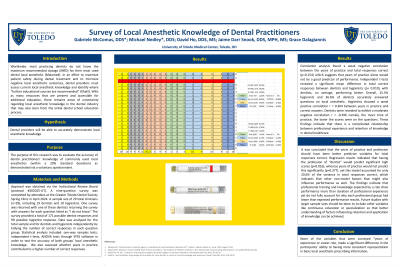Other
191 - Survey of Local Anesthetic Knowledge of Dental Practitioners

- GM
Gabriele McComas, DDS
Pediatric Resident
University of Toledo
University of Toledo
Las Cruces, New Mexico, United States - MN
Michael P. Nedley, DDS
Program Director
University of Toledo Medical Center
Toledo, Ohio, United States
Presenting Author(s)
Program Director(s)
Introduction: There are 202,304 practicing dentists in the United States. Healthcare systems should have an environment that promotes patient safety (including dental offices). Local anesthetic education and administration are areas of interest, especially in pediatric dentistry. Literature exists on improper dosage of local dental anesthetics from poor pain management to systemic toxicity. Prior to medication administration, therapeutic dose, medication strength or concentration, and duration should be considered.
Purpose: The purpose of this research was to evaluate the accuracy of dental practitioners’ knowledge of commonly used local anesthetics (within a 20% standard deviation) as demonstrated via a voluntary questionnaire.
Methods: Approval was obtained via the Institutional Review Board (protocol #302025-UT). The questionnaire was completed by attendees at the Greater Toledo Dental Society Spring Clinic. Ten hygienists and 19 dentists were surveyed and data was gathered and interpreted. SPSS analysis was conducted to evaluate variables that could affect likelihood of correct responses.
Results: Correlation analysis found a weak negative correlation between the years of practice and total responses correct, (P = .154) which suggests that years of practice alone would not be a good predictor of performance. Independent t-tests revealed a significant mean difference in total correct responses between dentists and hygienists (P = .010), with dentists, on average, performing better. Overall, 25.5% hygienists and 36.6% of dentists accurately answered questions on local anesthetic.
Conclusions: None of the variables made a difference in having more consistent representation in basic local anesthetic prescribing information.
Identify Supporting Agency and Grant Number:

.jpg)